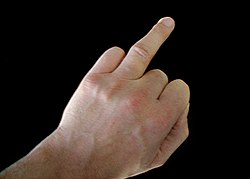Ring finger
This articleneeds additional citations forverification.(December 2022) |
| Ring finger | |
|---|---|
 A left human hand with the ring finger extended | |
| Details | |
| Artery | Proper palmar digital arteries, dorsal digital arteries |
| Vein | Palmar digital veins,dorsal digital veins |
| Nerve | Dorsal digital nerves of radial nerve, Dorsal digital nerves of ulnar nerve, Proper palmar digital nerves of median nerve |
| Identifiers | |
| Latin | digitus IV manus, digitus quartus manus, digitus annularis manus, digitus medicinalis |
| TA98 | A01.1.00.056 |
| TA2 | 154 |
| FMA | 24948 |
| Anatomical terminology | |
Thering finger,third finger,[1]fourth finger,[2][3]leech finger,[4]orannularyis the fourth digit of the human hand, located between themiddle fingerand thelittle finger.[5]
Sometimes the termring fingeronly refers to the fourth digit of aleft-hand,so named for its traditional association withwedding ringsin many societies, although not all use this digit as the ring finger. Traditionally, a wedding ring was worn only by the bride or wife, but in recent times more men also wear a wedding ring. It is also the custom in some societies to wear anengagement ringon the ring finger.
Inanatomy,the ring finger is calleddigitus medicinalis,the fourth digit,digitus annularis,digitus quartus,ordigitus IV.In Latin, the wordanulusmeans "ring",digitusmeans "digit", andquartusmeans "fourth".
Etymology
[edit]The origin of the selection of the fourth digit as the ring finger is not definitively known. According to László A. Magyar, the names of the ring finger in many languages reflect an ancient belief that it is a magical finger. It is named after magic or rings, or callednameless(for example, inChinese:Ngón áp út / ngón áp út;pinyin:wúmíng zhǐ;lit.'unnamed finger').[6]
InJapanese,it is calledDược chỉ(kusuri yubi,lit. 'medicine finger'), deriving its name from the fact that it was frequently used when takingtraditional powdered medicine,as it was rarely used otherwise and hence was considered the cleanest of all.[7]
In other languages such asSanskrit,Finnish,andRussian,the ring finger is called "Anamika", "nimetön", and "Безымянный" (bezymianny,"nameless" ), respectively.
In Semitic languages such asArabicandHebrew,the ring finger is calledbansur(meaning "victory" ) andkmitsa(meaning "taking a handful" ), respectively.
History
[edit]Beforemedical sciencediscovered how thecirculatory systemfunctioned, people believed that a vein ran directly from the fourth digit on the left hand to the heart.[8]Because of the hand–heart connection, they chose the descriptive namevena amoris,Latin for the vein of love, for this particular vein.[9]
Based upon this name, their contemporaries, purported experts in the field of matrimonial etiquette, wrote that it would only be fitting that the wedding ring be worn on this digit. By wearing the ring on the fourth digit of the left hand, a married couple symbolically declares their eternal love for each other.[10]
In Britain, only women tended to wear a wedding ring until after theWorld Wars,when married male soldiers started to wear rings to remind them of their wife.[11]
Contemporary customs
[edit]This sectionneeds additional citations forverification.(January 2024) |
Western customs
[edit]
InWestern cultures,a wedding ring is traditionally worn on the fourth digit, commonly called the "ring finger". This developed from the Romananulus pronubis,when a man would give a ring to the woman at their betrothal ceremony. Blessing the wedding ring and putting it on the bride's finger dates from the 11th century.
In medieval Europe, during theChristianwedding ceremony, the ring was placed in sequence on the thumb, index, middle, and ring fingers of the left hand. The ring was then left on the ring finger.
In a few European countries, the ring is worn on the left hand prior to marriage, then transferred to the right during the ceremony. For example, anEastern Orthodox Churchbride wears the ring on the left hand prior to the ceremony, then moves it to the right hand after the wedding. In England, the 1549 Prayer Book declared "the ring shall be placed on the left hand". By the 17th and 18th centuries, the ring could be found on any digit after the ceremony — even on the thumb.
The wedding ring is generally worn on the ring finger of the left hand in the former British Empire, certain parts of Western Europe, certain parts of Catholic Mexico, Bolivia, Chile, and Central and Eastern Europe. These include: Australia, Botswana, Canada, Egypt, Ireland, New Zealand, South Africa, the UK, and the US,[12]as well as France, Italy, Portugal, Sweden, Finland, Czech Republic, Slovakia, Switzerland, Netherlands [if Catholic], Croatia, Slovenia, Romania, Catalonia, Valencia, and the Balearic Islands. In Spain, the ring is generally worn on the right hand.
The wedding ring is worn on the ring finger of the right hand in some Orthodox and a small number of Catholic European countries, some Protestant Western European, as well as some Central and South American Catholic countries.[13]In Eastern Europe, these include Belarus, Bulgaria, Georgia, Latvia, Lithuania, North Macedonia, Russia, Serbia, and Ukraine. In Central or Western Europe, these include Austria, Belgium, Denmark, Germany, Greece, Hungary, Poland, the Netherlands (if not Catholic), Norway, and Spain (except in the Catalan-speaking regions). In Central or South America, these include Colombia, Cuba, Peru, and Venezuela.
In Turkey, Lebanon, Syria, Romania, and Brazil, the ring is worn on the right hand until the actual wedding day, when it is moved to the left hand.
In western guitar music, "I-M-A" is a style of plucking guitar strings, where "I" means index finger, "M" means middle finger, and "A" means ring finger. This is a popular type of "finger style" guitar playing, where the "A" comes from Latin, where the word anulus means ring.[14]
Middle Eastern, Jewish, and Asian customs
[edit]InSinhaleseandTamilculture, the groom wears the wedding ring on his right hand, but the bride wears it on her left hand ring finger. This can be seen in countries likeSri Lanka,which has a rich Sinhalese and Tamil cultural influence on the society.[15]
A wedding ring is not a traditional part of the religiousMuslim wedding,and wedding rings are not included in mostIslamiccountries. If a wedding ring is worn in an Islamic country, however, it may be worn on either the left (such is the custom inIran) and for example (in Jordan the right ring finger for engagement and the left ring finger for marriage). As opposed to the wedding ring, use of a ring to denotebetrothal or engagementis quite prevalent in Muslim countries, especially those in West and Asia. These rings may be worn on the ring finger of either the right or left hand by both men and women.
In a traditionalJewish weddingceremony, the wedding ring is placed on the bride's right-hand index finger,[16]but other traditions place it on the middle finger or the thumb, most commonly in recent times.[17]Today, the ring usually is moved to the left hand ring finger after the ceremony. Some Jewish grooms have adopted wearing a wedding ring, but inOrthodox Judaism,most men do not wear wedding rings.
Rings are not traditional in anIndian wedding,but in modern society, it is becoming a practice to wear rings for engagements if not for actual marriage. Although the left hand is considered inauspicious for religious activities, a ring (which is not called a wedding ring) is still worn on the left hand. Men generally wear the rings on the right hand and women on the left hands.
See also
[edit]- Digit ratio,comparative lengths of the index finger and ring finger and androgen levels in utero
- Finger numbering
References
[edit]- ^"Synonyms of ring finger | Thesaurus".thesaurus.Retrieved17 August2022.
- ^"ring finger".Collins English Dictionary.Retrieved17 August2022.
- ^"fourth finger".Medical Dictionary.Retrieved17 August2022.
- ^"How the 'Ring Finger' Got Its Name".Merriam Webster Dictionary.Retrieved17 August2022.
- ^"Synonyms of annulary | Thesaurus".thesaurus.Retrieved17 August2022.
- ^Magyar, László A. (1990)."Digitus Medicinalis — the Etymology of the Name".Actes du Congr. Intern. d'Hist. de Med. XXXII., Antwerpen.pp. 175–179. Archived fromthe originalon 23 January 2008.Retrieved2 September2009.
- ^"Japanese Vocabularies: Talking about human body".Crunchy Nihongo!.17 September 2017.
- ^Kunz, George Frederick (1917).Rings for the finger: from the earliest known times, to the present, with full descriptions of the origin, early making, materials, the archaeology, history, for affection, for love, for engagement, for wedding, commemorative, mourning, etc.J. B. Lippincott company. pp. 193–194.
- ^Mukherji, Subha (2006),Law and Representation in Early Modern Drama,Cambridge University Press, pp. 35–36,ISBN0521850355
- ^"Ruby And The Wolf".Retrieved22 July2023.
- ^"Wedding rings: Have men always worn them?".BBC.8 April 2011.
World War II is considered to have heralded a seismic shift, as many Western men fighting overseas chose to wear wedding rings as a comforting reminder of their wives and families back home.
- ^"What hand does a wedding ring go on for a man".Alpine Rings.
- ^"Why in the Orthodox tradition do we wear the wedding ring on the left hand?".antiochian.org.
- ^"Right Hand Planting Technique".douglasniedt.
- ^"A Sri Lankan Tamil Hindu Wedding"(PDF).Archived fromthe original(PDF)on 3 September 2012.
- ^"Guide to the Jewish Wedding".aish.9 May 2009.
- ^Sperber, David (1995).Minhagei Yisrael, Jerusalem (Hebrew).Vol. 4. pp. 92–93.
